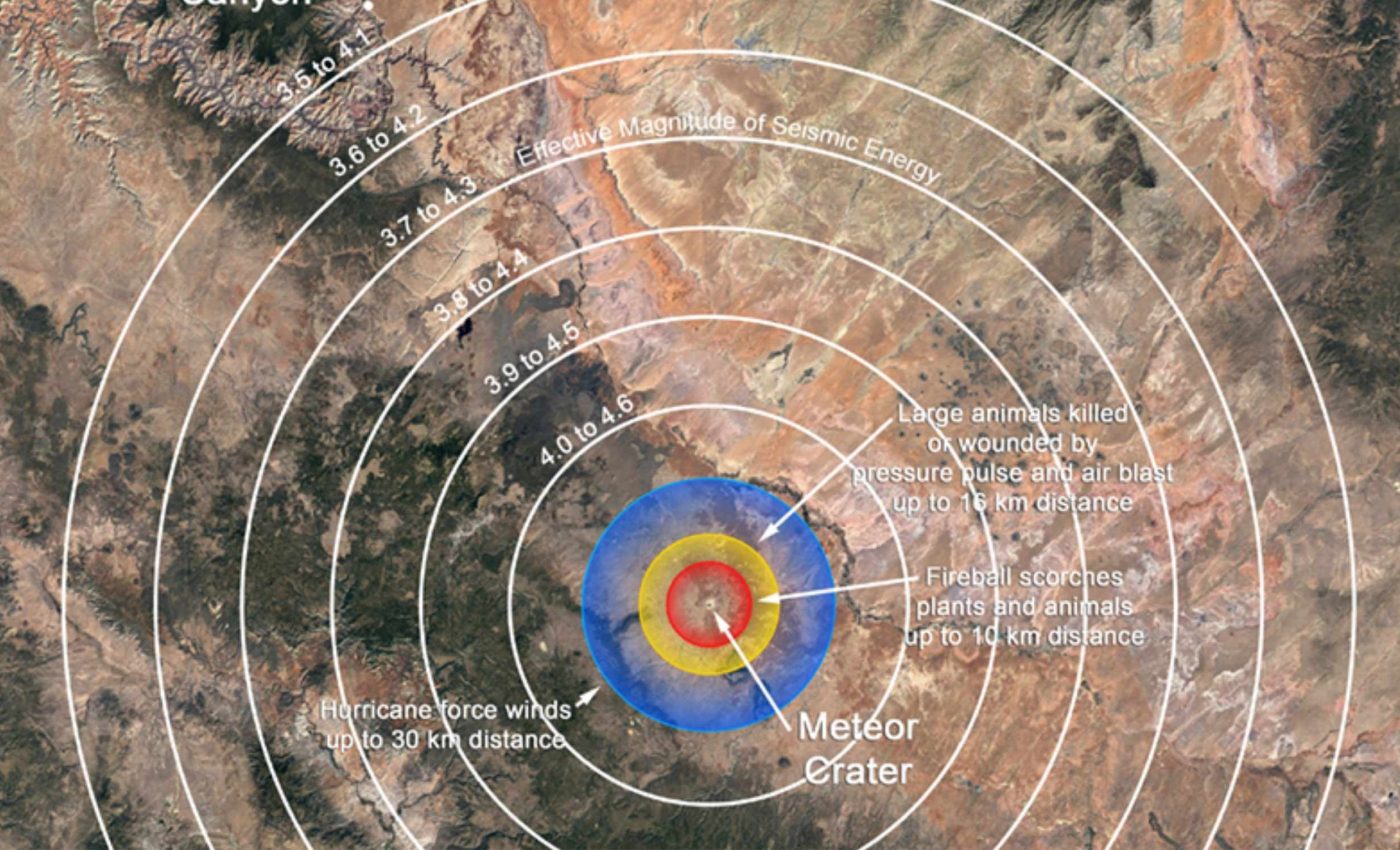
Giant meteorite may have caused a colossal landslide in the Grand Canyon 56,000 years ago
A new line of evidence links Arizona’s Meteor Crater to a huge landslide and cliff collapse that blocked the Colorado River roughly 56,000 years ago.
The event likely created a long, temporary lake inside the Grand Canyon and left telltale debris high on cave walls.
The scale is striking. One landslide appears to have bottled up the river and backed water upstream for about 39 miles, flooding caves perched far above today’s flow.
Cliffs, meteors, and landslides
In a new study, researchers tied driftwood and lake sediments in high Grand Canyon caves to a single ancient flood pulse, then matched that pulse to the age of the Meteor Crater impact.
The proposed trigger was shaking from the impact that loosened a tall cliff near Nankoweap Canyon.
The mouth of Stanton’s Cave sits about 150 feet above the river, yet its floor holds driftwood and lake mud.
Those materials mark an unusual, short lived rise in water level that would not be produced by seasonal runoff or common floods.
Lead researcher Karl Karlstrom of the University of New Mexico (UNM) and colleagues combined field mapping with new laboratory dates to narrow the window.
The team focused on wood fragments, slack water silts, and the elevations of several high alcoves scattered along Marble Canyon and the Colorado River basin.
“It would have required a ten-times-bigger flood level than any flood that has happened in the past several thousand years,” said Karlstrom.
Lake blocked by meteor landslide
The evidence points to a paleolake, an ancient lake that no longer exists, that filled behind a natural dam. Water would have pooled until it overtopped the debris and then rapidly cut through.
That dam was likely a landslide dam caused by the meteor strike, a temporary river blockage made of rockfall and rubble. Such dams are unstable, and they usually fail within weeks to years as water carves through the pile.
The team dated driftwood with radiocarbon dating, a method that estimates age from the decay of carbon 14. Four samples from Stanton’s Cave and a downstream alcove clustered near 55,000 years.
Lake silts yielded a luminescence dating result that centered near 56,000 years. Luminescence dating is a test that measures trapped light in minerals to find burial time.
Those ages were then compared with the impact age of Meteor Crater. The overlap suggests the landslide and the impact were essentially the same geologic moment, close enough in time to be connected.
Shaking from a distant blast
Impact modeling indicates a local earthquake equivalent near magnitude 5.4 at the crater. After traveling about 100 miles to the Grand Canyon, the effective shaking would have felt like a magnitude 3.5 event.
That level of ground motion can rattle a tall, fractured cliff, especially one already weakened by joints and weathering. In steep terrain, shaking can tip unstable blocks into motion.
The study describes how seismic waves and a pressure shock wave, a fast pressure pulse from the blast, could both contribute to slope failure. The combination is a short lived push that acts on slopes already near their tipping point.
Once rock fills a narrow canyon floor, the river can be choked by boulders and dust. Water then stacks up upstream, spreads into side alcoves, and drops sediment in still pools.
Timing that lines up
What makes the case compelling is the alignment of multiple clocks. Driftwood ages cluster near 55,000 years, lake sediments read about 56,000 years, and three independent crater age estimates fall in the same bracket.
The authors emphasize a careful distinction between cause and coincidence. The ages are statistically indistinguishable, but independent confirmation from more sites would reduce remaining uncertainty.
Either way, the same short interval explains wood in caves and the shape of the lake beds. The story does not rely on a single sample or one cave.
The distance between the crater and Nankoweap Canyon is large, yet within the reach of strong waves that cross the Colorado Plateau. Those waves arrive in seconds, giving cliffs little time to resist.
Why this matters today
Meteor Crater is one of the best preserved impact sites on Earth, with a 0.75 mile wide bowl and a rim that rises hundreds of feet.
“A similar size impact event today could destroy a city the size of Kansas City,” said David Kring, principal scientist at the Lunar and Planetary Institute.
The Grand Canyon study adds a fresh hazard to that picture. Impacts can trigger landslides far from the crater, especially in mountains, with river blockages that threaten communities downstream.
It also shows why better dates matter. Radiocarbon at the edge of its range and luminescence from cave silts, used together, can resolve events that happen within a narrow slice of time.
Finally, the work links two famous sites with a single process. A brief geologic shock appears to have reshaped a reach of the Colorado River, then vanished as the river chewed through the dam and drained the lake.
Image credit: LPI\David A. Kring.
—–
Like what you read? Subscribe to our newsletter for engaging articles, exclusive content, and the latest updates.
Check us out on EarthSnap, a free app brought to you by Eric Ralls and Earth.com.
—–













